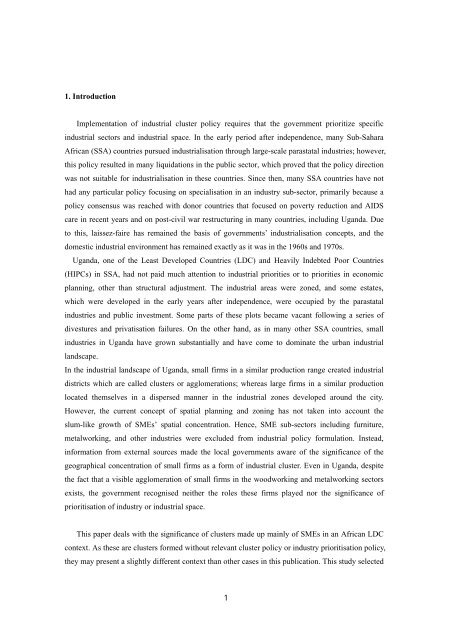Information - ARRIDE - IDE-JETRO
Information - ARRIDE - IDE-JETRO
Information - ARRIDE - IDE-JETRO
Create successful ePaper yourself
Turn your PDF publications into a flip-book with our unique Google optimized e-Paper software.
1. Introduction<br />
Implementation of industrial cluster policy requires that the government prioritize specific<br />
industrial sectors and industrial space. In the early period after independence, many Sub-Sahara<br />
African (SSA) countries pursued industrialisation through large-scale parastatal industries; however,<br />
this policy resulted in many liquidations in the public sector, which proved that the policy direction<br />
was not suitable for industrialisation in these countries. Since then, many SSA countries have not<br />
had any particular policy focusing on specialisation in an industry sub-sector, primarily because a<br />
policy consensus was reached with donor countries that focused on poverty reduction and AIDS<br />
care in recent years and on post-civil war restructuring in many countries, including Uganda. Due<br />
to this, laissez-faire has remained the basis of governments’ industrialisation concepts, and the<br />
domestic industrial environment has remained exactly as it was in the 1960s and 1970s.<br />
Uganda, one of the Least Developed Countries (LDC) and Heavily Indebted Poor Countries<br />
(HIPCs) in SSA, had not paid much attention to industrial priorities or to priorities in economic<br />
planning, other than structural adjustment. The industrial areas were zoned, and some estates,<br />
which were developed in the early years after independence, were occupied by the parastatal<br />
industries and public investment. Some parts of these plots became vacant following a series of<br />
divestures and privatisation failures. On the other hand, as in many other SSA countries, small<br />
industries in Uganda have grown substantially and have come to dominate the urban industrial<br />
landscape.<br />
In the industrial landscape of Uganda, small firms in a similar production range created industrial<br />
districts which are called clusters or agglomerations; whereas large firms in a similar production<br />
located themselves in a dispersed manner in the industrial zones developed around the city.<br />
However, the current concept of spatial planning and zoning has not taken into account the<br />
slum-like growth of SMEs’ spatial concentration. Hence, SME sub-sectors including furniture,<br />
metalworking, and other industries were excluded from industrial policy formulation. Instead,<br />
information from external sources made the local governments aware of the significance of the<br />
geographical concentration of small firms as a form of industrial cluster. Even in Uganda, despite<br />
the fact that a visible agglomeration of small firms in the woodworking and metalworking sectors<br />
exists, the government recognised neither the roles these firms played nor the significance of<br />
prioritisation of industry or industrial space.<br />
This paper deals with the significance of clusters made up mainly of SMEs in an African LDC<br />
context. As these are clusters formed without relevant cluster policy or industry prioritisation policy,<br />
they may present a slightly different context than other cases in this publication. This study selected<br />
1




![Title [書評] 廣田義人著『東アジア工作機械工業の技術形成 ... - ARRIDE](https://img.yumpu.com/47139953/1/184x260/title-arride.jpg?quality=85)






